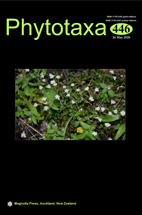Abstract
During the study of Monoon Miquel (1865: 15) in western Malesia, we found two individuals of this genus cultivated in the Bogor Botanic Garden. According to the catalogue An alphabetical list of plant species cultivated in the Bogor Botanic Gardens, these plants were collected from South Kalimantan in 1977 (Sari et al. 2010). Leaves and aggregate fruits of these plants indicated that they are a species of Monoon (Annonaceae). The leaves exhibit eucamptodromous venation, decurrent insertion of secondary veins, and scalariform tertiary veins. The aggregate fruits consist of many one-seeded, stalked monocarps. However, other characters indicated that they differ from already known Monoon species. We consider these plants, therefore as new to science.
This new species shares characters with M. lateriflorum (Blume) Miquel (1865: 19), previously Guatteria lateriflora Blume (1825: 20) and M. sclerophyllum (Hook. & Thomson) Xue & Saunders in Xue et al. (2012: 1033), previously Polyalthia sclerophylla Hooker & Thomson (1872: 65), in having ramiflorous, fasciculate inflorescences, many-flowered fascicles, oblong petals slightly constricted basally and many-stipitate monocarps (ca. 30) in aggregate fruits. However, other characters of leaves, flowers, and monocarps indicate that this new material differs from M. lateriflorum, and M. sclerophyllum (Table 1).

